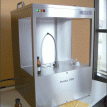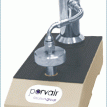CNG Instruments Sdn Bhd
37A, JALAN ANGGERIK VANILLA AB
31/AB, KOTA KEMUNING,
SHAH ALAM, Selangor, 40460
Malaysia
ph: 603-51226821
fax: 603-51223821
sales
POROMETER
The Measurement Principle of Capillary Flow Porometry
A capillary flow Porometer uses the existing physical interaction between liquids and a capillary space: the liquid is sucked into this capillary opening. Different parameters determine the height obtained by the liquid inside this capillary opening: the diameter of the opening, air pressure, the interphase interaction between the liquid and solid, the density of the liquid, temperature, viscosity, etc. Already in 1921, Washburn considered this existing relationship between pressure and pore size. He established a simplified rule for this effect, whether a liquid is pushed into the pores as in mercury porosimetry or a liquid is pushed out of the pores as is the case in capillary flow porometry. The following relationship is valid for these methods:
Pressure = 4 * γ * cos θ * (shape factor) / diameter
With the pressure in bar, the diameter in μm, γ the surface tension of the wetting liquid, θ the contact angle of the liquid on the solid. The shape factor is a parameter depending on the shape and the path of the pore inside the material.
The surface tension γ is a measurable physical property and is available for many liquids. Thecontact angle θ however depends on the interaction between the material and the wetting liquid. Typical wetting fluids used in porometry are perfluoroethers. They have a low surface tension and a contact angle of 0° with nearly all materials.
A capillary flow porometer consists of one or more pressure and flow sensors with a separate pressure control. The instrument will build up pressure inside the pressure chamber (yellow zone) starting from ambient pressure, over a wetted sample (in red). Gradually the pores will start to open starting with the largest pores and a gas flow will be measured. The pressure build up is performed until all pores are opened and the sample has completely dried during this so-called wet curve. The instrument deflates and a second run is performed, called the dry curve. This curve is necessary for the calculation of all measured parameters: largest and smallest pores, mean flow pore size, and so on.

The pressure may be increased by the pressure control in two differentiated ways. A first one is the linear increase of pressure over time with immediate data sampling for pressure and flow. We provide this pressure scan methodology in our POROLUXTM 100 series. In the POROLUXTM1000 series, the pressure is increased in different steps. At each pressure step, both pressure and flow are monitored and a datapoint is taken when stabilization criteria are met. Thispressure step/stability method provides more accurate information, and can also be used at increased pressures.
Porometer.com also allows you to determine the first bubble point with the calculated bubble point and/or the “true” measured bubble point method.
Measured parameters with the CFP method
All measurements performed in a capillary flow porometer consists of two gas flow curves as a function of (relative) pressure increase. A typical measurement is shown in the figure below (left image).The instrument itself will calculate from these two curves all important parameters. Typical parameters are: first bubble point or largest pore, mean flow pore, smallest pore, cumulative flow, differential flow and corrected differential flow.

The first bubble point or largest pore is a special parameter which needs some further background information, which can be read on a dedicated page. The smallest porerepresents the smallest openings inside the material. These are opened right before the filter has completely dried. The smallest pores are therefore calculated at the point where the wet curve (blue) and dry curve (red) start to coincide. The average pore size or mean flow pore size is calculated at the pressure where the wet curve and the “half-dry” curve (green) cross. The half-dry curve is obtained by the mathematical division by 2 of the data originating from the dry curve, as requested by the standard ASTM F 316-03.
From the wet and dry curves also the pore size distribution is calculated, shown with the cumulative, differential and corrected differential flow, see the figure below (right). The differential flow shows the percentage of pores present. The cumulative flow represents the sum of all these differential values between 0 and 100%. The corrected differential takes also the differences in pore size relative to its pressure step into account. More information on these parameters can be found in the application note: Calculations used in porometry.

Pressure scan method
- The Pressure Scan method is the technology we provide in our POROLUXTM 100 series. In this methodology we use a linear pressure increase over time. Data sampling of pressure and flow is performed continuously. This results in fast measurement with very reproducible data as is shown below, extremely suited for quality control.
Special algorithms were written for very porous materials, like non-wovens to counter their extreme behaviour like the very fast increase in gas flow at very low relative pressures. A complete overview of our POROLUXTM 100 series can be found in the instrument section.
Pressure Step/Stability Method
With the pressure step/stability method an inlet valve for the gas is a large needle valve which opens with very accurate and precise movements. To increase pressure, the valve opens to a precise point and then stops its movement. A datapoint is recorded when the used defined stability algorithms are met for both pressure and flow. In this way, the porometer detects the opening of a pore at a certain pressure and waits until all pores of the same diameter are completely opened before accepting a datapoint. This results in very accurate measurement of pore sizes and allows a calculation of the real pore size distribution from simple to very complex filters and membranes.
This method also allows the measurements of smaller pores, down to 18 nm, as higher pressures can be obtained using this methodology. A complete overview of the POROLUXTM 1000 series can be found in the instrument section.
First Bubble Point or FBP
One of the most important parameters measured by a porometer is the first bubble point or FBP. This point defines the largest pores present inside the material. ASTM F-316-03 defines the FBP as the pressure at which the first continuous gas bubbles are detected. In thecalculated FBP operating mode, the FBP is defined at different flows, e.g. at 30, 50, 100 ml/min; the corresponding pressure is recalculated into the pore size. This is however far away from a visual observation of air bubbles and very often, this calculation does not represent the real opening of the largest pores. In the figure below it is clear that increasing the pressure also results in a certain gas flow toward the sample but not actually through the pores of the sample. Erroneous calculations are therefore easily made.
To counter this effect, we developed for the POROLUXTM 1000 series an actual measured bubble point detection mode. In this mode, the instrument runs in a gas flow control regime, rather than the usual pressure control regime for normal measurements.
With an impregnated, wet sample, the POROLUX™ 1000 sample chamber forms a closed system. Starting from a relative pressure of 0 bar, we add a constant gas flow by the flow regulator. As the volume inside the sample chamber is fixed, this constant flow will result in a linear rise of the pressure above the sample. At the moment the first and largest pore is opened, there will be a change in this linear pressure increase (or its first derivative over time). This chance can be regarded as the true first bubble point of the material. This method to measure the FBP shows an excellent reproducibility and is unique in the market.

Both the POROLUXTM 100 and POROLUXTM 1000 series are available in different models to suit the needs of our clients in the best possible way: different pressure and flow ranges can be chosen for increased sensitivity for special applications.
The POROLUXTM 1000 comes standard with the measured bubble point method, the calculated bubble point method remains possible of course. Also, the POROLUXTM 1000 comes with a wide variety of accessories, as it is the designated R&D instrument.
Copyright 2012 CNG Instruments Sdn Bhd. All rights reserved.
CNG Instruments Sdn Bhd
37A, JALAN ANGGERIK VANILLA AB
31/AB, KOTA KEMUNING,
SHAH ALAM, Selangor, 40460
Malaysia
ph: 603-51226821
fax: 603-51223821
sales




